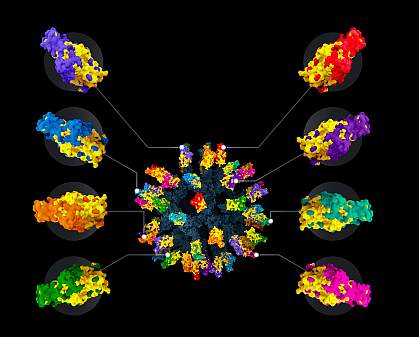You are here
August 16, 2022
Fighting current and future coronaviruses with a single vaccine
At a Glance
- An experimental vaccine produced an immune response to a range of different coronaviruses in mice and monkeys, including SARS-CoV-2.
- It protected against related viruses that weren’t part of the vaccine, suggesting effectiveness against future variants of SARS-CoV-2 and other coronaviruses.

Vaccines against SARS-CoV-2, the virus that causes COVID-19, have greatly reduced the risk of severe disease and death. However, SARS-CoV-2 continues to mutate in unpredictable ways that can reduce the effectiveness of the current vaccines. The risk of a new coronavirus spilling over from animals to people also remains a serious concern.
Researchers are trying to produce a vaccine that would protect people from both future SARS-CoV-2 variants and related coronaviruses that might pose a threat. To this end, an NIH-funded team led by Dr. Pamela Bjorkman from the California Institute of Technology created a nanoparticle-based vaccine that prompts B cells, which produce antibodies, to recognize parts of coronaviruses that mutate less often.
Current COVID-19 vaccines target parts of the SARS-CoV-2 virus that quickly mutate. Like those, the nanoparticles in the investigational vaccine display a part of the coronavirus spike protein called the receptor binding domain (RBD), which coronaviruses use to enter human cells.
However, the team combined RBDs from eight different coronaviruses for their vaccine. Each nanoparticle included 60 RBDs, so that any two adjacent RBDs were rarely from the same coronavirus. B cell receptors bind strongly to identical targets that are near each other. So, this design encouraged B cells to target areas that were similar across the RBDs—ones that tend to mutate more slowly.
The researchers tested the new vaccine, called mosaic-8, as well as a nanoparticle vaccine made only with RBDs of SARS-CoV-2. Results were published on August 5, 2022, in Science.
The team used mice that were engineered to make the human ACE2 protein—the target of the SARS-CoV-2 spike. Following vaccination with mosaic-8, the mice produced antibodies that recognized a range of coronaviruses. As expected, the antibodies recognized parts of the RBDs that remained similar between coronaviruses.
When challenged with SARS-CoV-2, mice that received either of the nanoparticle vaccines were protected against symptoms of severe COVID-19. However, only the mosaic-8 vaccine also protected mice against a related virus, SARS-CoV, which caused the SARS outbreak of 2003. This protection occurred even though SARS-CoV wasn’t part of the mosaic-8 nanoparticle.
Similar results were seen in non-human primates. Monkeys that received either the mosaic-8 nanoparticle or the SARS-CoV-2 nanoparticle were protected against severe COVID-19. But those that received the mosaic-8 vaccine were also protected against the SARS-CoV-2 Delta variant and SARS-CoV, neither of which were included in the vaccine.
“We can't predict which virus or viruses among the vast numbers in animals will evolve in the future to infect humans to cause another epidemic or pandemic,” Bjorkman says. “What we're trying to do is make an all-in-one vaccine protective against SARS-like [coronaviruses]. This sort of vaccine would also protect against current and future SARS-CoV-2 variants without the need for updating.”
The researchers are now preparing to test mosaic-8 in a human clinical trial.
—by Sharon Reynolds
Related Links
- T Cells Protect Against COVID-19 in Absence of Antibody Response
- Intranasal Proteins Could Protect Against COVID-19 Variants
- Antibodies Recognize New SARS-CoV-2 Omicron Variant after Booster
- COVID-19 Immune Response Improves for Months After Vaccination
- COVID-19 Vaccines Induce Immune Response to Omicron
- Measuring Protection after COVID-19 Vaccination
- Experimental Vaccine Protects Against Multiple Coronaviruses
- Measles Vaccine Used as Base for Experimental COVID Vaccine
- Nanoparticle Vaccine Against Various Coronaviruses
- Nanoparticle-Based Flu Vaccine
- COVID-19 Research
- COVID-19 (CDC)
References: Mosaic RBD nanoparticles protect against challenge by diverse sarbecoviruses in animal models. Cohen AA, van Doremalen N, Greaney AJ, Andersen H, Sharma A, Starr TN, Keeffe JR, Fan C, Schulz JE, Gnanapragasam PNP, Kakutani LM, West AP Jr, Saturday G, Lee YE, Gao H, Jette CA, Lewis MG, Tan TK, Townsend AR, Bloom JD, Munster VJ, Bjorkman PJ. Science. 2022 Aug 5;377(6606):eabq0839. doi: 10.1126/science.abq0839. Epub 2022 Aug 5. PMID: 35857620.
Funding: NIH’s National Institute of Allergy and Infectious Diseases (NIAID) and Office of the Director (OD); Wellcome Leap; Bill and Melinda Gates Foundation; Caltech Merkin Institute; George Mason University; Howard Hughes Medical Institute; Damon Runyon Cancer Research Foundation; Townsend-Jeantet Charitable Trust; EPA Cephalosporin Fund.
